Widerøe
Widerøes Flyveselskap AS, trading as Widerøe, is a Norwegian airline, and is the largest regional airline operating in the Nordic countries. The airline's fleet of 40 Bombardier Dash 8 aircraft, and 3 Embraer E190-E2 aircraft, serves 41 domestic and 6 international destinations. Widerøe has a turnover of 4 billion kr; carries 2.86 million annual passengers; has 3,000 employees and performs 450 take-offs and landings each day.[1] Public service obligation services to regional airports makeup slightly less than half of Widerøe's operations. The remaining services are to primary airports in Northern Norway, and services from Sandefjord Airport, Torp and Bergen Airport, Flesland to other primary airports, and some international services from Oslo/Gardermoen, Sandefjord/Torp, Kristiansand/Kjevik, Stavanger/Sola, Bergen/Flesland and Trondheim/Værnes.
 | |||||||
| |||||||
| Founded | 19 February 1934 | ||||||
|---|---|---|---|---|---|---|---|
| Operating bases | • Bergen • Bodø • Oslo • Sandefjord • Tromsø | ||||||
| Frequent-flyer program | EuroBonus | ||||||
| Fleet size | 45 | ||||||
| Destinations | 47 | ||||||
| Headquarters | Bodø, Norway | ||||||
| Key people | Stein Nilsen (CEO) | ||||||
| Website | wf.no | ||||||
The company's head offices are in Bodø, although it retains a large administrative center in Lysaker, Oslo.[2] The main bases are Sandefjord Airport, Torp, Bodø Airport, Tromsø Airport, Langnes, Bergen Airport, Flesland and Oslo Airport, Gardermoen. Widerøe's operations are focused on point-to-point transit, although the airline essentially feeds medium-haul and international airlines. Widerøe has interlining agreements and participates in EuroBonus for international flights.
The airline was established in 1934 by Viggo Widerøe, a notable Norwegian aviator, and was engaged in various general aviation activities in its early days. In 1936, Widerøe started scheduled seaplane flights and, from 1940, also ambulance flights. During the 1940s and 1950s, the airline increased its seaplane routes and established a fleet based on de Havilland Canada DHC-3 Otter and Noorduyn Norseman aircraft. From 1968, Widerøe started flying to STOLports in northern and western Norway using DHC-6 Twin Otters, and later also with Dash 7 aircraft. In 1989, Widerøe bought Norsk Air and started services from Sandefjord. During the 1990s, it replaced all its aircraft with Dash 8 aircraft; in the 2000s it was bought by the SAS Group and took over SAS Commuter's operations in northern Norway. In 2010, Widerøe took over regional SAS services in western Norway. In 2013, SAS Group sold 80% of the shares to WF Holding, an investment company controlled by Torghatten ASA, and in June 2016 the remaining 20% of the shares were transferred to WF Holding, ending SAS ownership of Widerøe, albeit still as a close regional partner of SAS.[3]
History
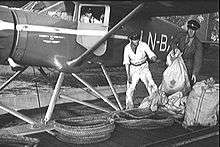
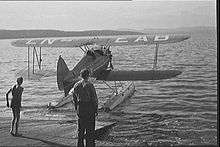
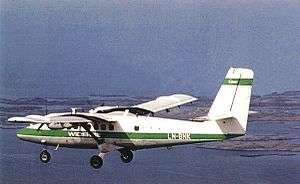
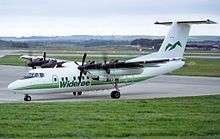
Widerøe was established on the foundations of two small aircraft operators. The first was the company Lotsberg & Skappel. The other was Widerøe & Bjørneby, which was founded by Viggo Widerøe and Halvor Bjørneby. During the winter, they stationed aircraft at mountain resorts and made revenue from flying skiers into the wilderness. Aerial advertising flights were introduced, in which a company or product name was painted on an aircraft's fuselage, with a neon-light version underneath, and leaflets dropped mid-flight.[4]
On 19 February 1934, Widerøe's Flyveselskap A/S was founded by Viggo Widerøe, Einar Isdahl, and Arild Widerøe. In 1935, the company started in the cartography business. In 1937, the company made 44 flights along the coast of Antarctica, covering 4,000 kilometres (2,500 mi) of coast at least 50 kilometres (31 mi) inland. These flights were ordered by Lars Christensen for cartography. During 1938, the company's Bogstad workshop and Birger Hønningstad started a joint venture in which Widerøe built Hønningstad Norge aircraft.
Following the outbreak of World War II, all pilots were conscripted into the military and there was a ban on civilian aviation. In 1940, the company started air ambulance flights for the military. Following the German invasion of Norway, many of Widerøe's pilots and aircraft were flown to Mjøsa where they served as part of the defence. All civilian aircraft were grounded during the occupation, and German authorities demanded that magnetos and propellers be handed in. The workshop at Bogstad was kept busy with the production of ambulance sleds for the German military. In secret, the company also started building the Hønningstad C-5 Polar ambulance aircraft at Bogstad.[5]
After the liberation of Norway in 1945, there was still a flight ban, and the employees at Bogstad were hired by the Royal Norwegian Air Force at Oslo Airport, Fornebu. The company received permission to fly from 2 February 1946. In 1947, Forenede Industrier bought the majority of the company. Viggo Widerøe was again hired as managing director.[6]
In 1948, the company merged with Narvik-based Polarfly, and changed its name to Widerøe's Flyveselskap & Polarfly A/S. The following year, the company began an aerial photography operation. In 1953, the company chose to differentiate and started production of emergency rafts; refrigerated garages in aluminium; and thermoelements for industry. In 1954, the company received a subcontract from Scandinavian Airlines System (SAS), the successor of DNL, to operate a seaplane route from Tromsø via Alta, Hammerfest, and Kirkenes to Vadsø. For this route, the company bought its first de Havilland Canada DHC-3 Otter.[7] On 1 July 1958, the company changed its name back to Widerøe's Flyveselskap A/S.
In 1969, Per Bergsland replaced Viggo Widerøe as CEO. In 1970, the company was split in two: the aerial photography division was sold to competitor Fjellanger, and the new company Fjellanger Widerøe was created. Scheduled services remained with Widerøe. The airline's last seaplane was decommissioned in 1971. In April 1980, Widerøe started an international service on behalf of SAS.
Destinations
Widerøe has been awarded public service obligation contracts by the Ministry of Transport and Communications to connect regional airports to primary airports. Twenty-five such airports were served in a contract running from 1 April 2009 to 31 March 2012, with the company having lost the bid for services to three. The services connect smaller communities and towns to regional centers and to primary airports that provide onwards service with jet aircraft.
Eight airports in Finnmark and one in Troms are connected to Tromsø Airport, with a limited number of services also connecting to two of the three primary airports in Finnmark—Alta and Kirkenes. Between Tromsø and Bodø, Widerøe serves six airports, of which two connect to Tromsø and all to Bodø. South of Bodø, there are six airports in Helgeland and Namdalen, which are all connected to Bodø and Trondheim Airport, Værnes. In Sogn og Fjordane and Sunnmøre, Widerøe connects four airports to Oslo Airport, Gardermoen and Bergen Airport, Flesland.[8]
Widerøe's main domestic hauling between primary airports is from its base at Sandefjord Airport, Torp. Services are provided up to five times per day to Trondheim, Stavanger and Bergen, as well as seasonal services to Bodø and Tromsø. In Northern Norway, Widerøe operates some services connecting primary airports, including the links from Tromsø to Alta, Hammerfest, Kirkenes and Vadsø Airport, and connecting Harstad/Narvik Airport, Evenes to Tromsø, Bodø and Trondheim.[8][9]
International services are provided to and from five Norwegian airports to seven foreign airports in Sweden, Denmark and the United Kingdom. From Sandefjord and Trondheim, Widerøe connects to Scandinavian Airlines' hub at Copenhagen Airport. From Oslo, Widerøe operates four daily services to Göteborg Landvetter Airport, as well as summer routes to Visby Airport and Bornholm Airport. From Bergen and Stavanger, Widerøe serves Aberdeen Airport. From Bergen Widerøe fly to Liverpool John Lennon Airport and from Stavanger; Newcastle Airport.[8]
In 2010, Widerøe took over the regional routes previously operated by SAS in Western Norway; these connect Kristiansand and Kristiansund Airport, Kvernberget to Stavanger and Bergen, and Haugesund and Molde to Bergen. These routes will replace the SAS Fokker 50 aircraft with -300 and Q400 aircraft.[10]
In 2016 the airline was awarded a five-year contract by the Norwegian Ministry of Transport and Communications to operate 13 of Norway's Public Service Obligation routes and will start operating the routes in April 2017.[11]
Codeshare agreements
Widerøe has codeshare agreements with the following airlines (as of February 2020):
|
FleetCurrent Widerøe De Havilland Canada DHC-8-100  Widerøe De Havilland Canada DHC-8-300  Widerøe De Havilland Canada Dash 8-400 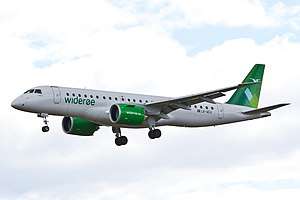 Widerøe Embraer 190-E2 Since 2000, the airline has operated a fleet consisting entirely of de Havilland Canada/Bombardier Dash 8 aircraft. As of 2018, Widerøe was the world's largest operator of the Dash 8-100 series, after Piedmont Airlines retired their fleet . As of 2012, Widerøe is the first and only airline in the world to operate every single variant of the Dash 8 simultaneously, and is one of the few airlines to ever operate all variants of the Dash 8, as well as the older DHC-6 Twin Otter and Dash 7. In January 2017, Widerøe announced it had signed a contract with Embraer for up to 15 new Embraer E2-E190 jets, with firm orders for three E190-E2 aircraft and purchase rights on 12 more jets from the Embraer E2 family.[13] The airline is the first operator of the E190-E2 aircraft.[14] The aircraft is Widerøe’s first jet aircraft, after previously operating an all-turboprop fleet. In April 2018, Wideroe received its first Embraer E190-E2. The delivery was the first E2 aircraft to be delivered to an airline. It was given to Wideroe by Embraer through a big ceremony of Embraer and Wideroe staff as well as media. Its first revenue flight occurred on 24 April 2018.[14] As of April 2020, the Widerøe fleet consists of the following aircraft:[15][16]
The Dash 8-100, Dash 8-200 and Dash 8-300 can operate on the many short runway airports in Norway, which Widerøe is the main operator on. The problem is, though, that the aforementioned planes are ageing, but de Havilland Canada/Bombardier Aerospace have quit producing those particular aircraft types, meaning that no direct replacement can be found. A feasible replacement could come from ATR with a STOL-modified 42 turboprop, but at this stage, knowing what aircraft the Dash 8s will be replaced with is mere speculation. ServiceEuroBonus frequent flyer points can be earned on all international routes and all commercial domestic routes. Points can be redeemed on international routes and domestic routes not part of the public service obligation.[9] Complimentary coffee and tea is offered on all flights with Embraer E190-E2, Dash 8 Q400 and Dash 8 300/Q300 aircraft if the flight is scheduled for 45 minutes or more. Snacks and cold drinks are for sale if the flight is scheduled for 25 minutes or more if the weather conditions allow it. On routes operated on Dash 8 100/Q200 aircraft, snacks and cold drinks are for sale only; no other refreshments (coffee and tea) are served on these aircraft, due to there being no galley on board. Only on flights scheduled for 25 minutes or more.[17] Incidents and accidents
ReferencesNotes
Bibliography
External links
| |||||||||||||||||||||||||||||||||||||